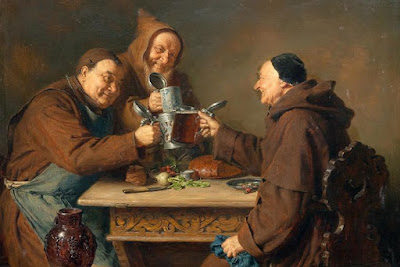Prayer before Meal, c.1663 - 1665 - Jan Steen
Reprinted from a 2019 Catholic Family News Article. Subscribe to CFN for more such articles.
St. Mark early in his Gospel recounts how Our Lord ate with sinners. "And it came to pass, that as he sat at meat in his house, many publicans and sinners sat down together with Jesus and his disciples. For they were many, who also followed him. And the scribes and the Pharisees, seeing that he ate with publicans and sinners, said to his disciples: Why doth your master eat and drink with publicans and sinners? Jesus hearing this, saith to them: They that are well have no need of a physician, but they that are sick. For I came not to call the just, but sinners" (Mark 2:15-17).
Just this past Easter Sunday I invited over to Easter dinner a few people. All of whom were not Catholic. One man, a friend of my mother, grew up Lutheran but has largely fallen away from any religious practice aside from occasional Bible reading while he hunts deer. The other man was a friend of my sister who grew up in a household that loved carnal desires, rock-n-roll, and what we might just call downright debauchery. And when I related to a friend of mine, let’s call him Jim, of their presence at dinner, he was outwardly scandalized. “Why would you invite them over to Easter dinner? Don’t you know they aren’t Catholic?”
“Yes, I certainly do,” I replied. I continued, “In fact, that’s why I invited them to begin with!” He was confused. So I took a few moments to explain.
We are often quick to condemn the sins of others – and rightfully so! But while we should admonish sinners, our battle in this world is not to chase away souls. Our Lord prayed, “Now this is the will of the Father who sent me: that of all that he hath given me, I should lose nothing” (John 6:39), and we who are called to help preserve and diffuse the Catholic Faith should pray that our actions likewise should lose not a single soul.
As a Third Order Dominican and as a catechist, I often say that we can never study the truths of the Faith enough. We cannot read the catechism or re-study Christian doctrine too much. So I reminded Jim that we first and foremost are in a battle. He certainly agreed. But, this battle is not one that will be won with an outward assault on our enemies. It will be won in the deepest reaches of our soul (cf. Matthew 11:12) and through our persistent, subtle actions that target souls held in slavery by the camp of Satan.
Whether we like it or not, we are in a battle, and this battle is one which we did not create. In fact, this battle has existed far before the errors of Vatican II even seeped into the Church. Our battle is namely the same that St. Paul referenced when he said, “For our wrestling is not against flesh and blood; but against principalities and powers, against the rulers of the world of this darkness, against the spirits of wickedness in the high places” (Ephesians 6:12). And we fight this battle by virtue of our Confirmation.
In the traditional Confirmation Rite, the bishop lightly slaps the cheek of the one who has been confirmed as an outward expression of the inward reality, namely that those confirmed must be ready to suffer all things, even death, for the sake of Jesus Christ.
And like a good and noble soldier, this war is not our cause. It has existed long before our time. In fact, we have been thrown into the very middle of the warfare as a paratrooper would land deep into the heat of the battle. And just as the noble soldier who undertakes such a perilous mission behind enemy lines knows, his battle ends only at death. We too, as confirmed Catholics, must continue to remind ourselves that our battle is one that will end with the triumph of the Immaculate Heart, but it is a battle in which we must die. We must die to ourselves while persisting in the state of sanctifying grace until death. For the battle is fought first within ourselves through penance and prayer (1 Corinthians 9:27) before we can battle against the principalities of this world of darkness.
So imagine yourself in the heat of battle. Immorality and carnal lust swirls around us. Debauchery, idolatry, greed, and envy reign in the highest places. Darkness is around. You paratroop in and hit the ground. Everything goes black. Suddenly you awaken to the sound of battle. So what do you do?
What soldier in the midst of battle does not arise and double back in order to pick up a sufficient weapon lest he stand no chance? The same is true for the spiritual conduct we find ourselves in. It doesn’t matter if we were baptized and confirmed long ago before the battled raged as it does today. It doesn’t matter if we are timid by nature or not. On the contrary, we are in the battle! Our focus is not to understand why we got here – the immediate focus is on what we can do to fight the good fight and press on.
And our weapons in this battle are plentiful. In fact, Heaven has showered our battlefield with a myriad of weapons. My focus as a catechist is on the Doctrine of Christ which is sweet and awe-inspiring to souls. There are in fact other weapons though – the Rosary, the various Scapulars given by our Lady, the St. Benedict Medal, the Miraculous Medal, the Cord of St. Philomena, and countless others.
My “weapon of choice” though besides these Sacramentals which I wholeheartedly encourage nonetheless, is the sweetness of the Doctrine of Christ. For those wishing to ground yourself in authentic Catholic teaching, I recommend a few essential books that must be in your library.
Firstly, the Baltimore Catechism and the Roman Catechism are foundational. Use the Baltimore Catechism with your children and read it yourself too. Keep these simple but true axioms of the Faith in mind. Whereas modern churchman are accustomed to lengthy and complicated theological studies, the Catechisms provide in clear and easy to understand language the truths of the Faith that are timeless and unchanging.
Next, pick up a copy of the Douay Rheims Bible and pair with it a copy of Fr. George Leo Haydock's Catholic Bible Commentary. Fr. Haydock's Douay Bible with his extended commentary was originally published in 1811 and became the bestselling English Catholic Bible in the 19th century in the world. The text is available freely online - and the same is true for the Baltimore Catechism and the Roman Catechism.
And as any good soldier would do as he surveys the battlefield and fills his satchel, you need some stronger weapons for the stronger enemies on the battlefield. In our spiritual conquest, we too will find those enemies. Whether they be in the form of the unrepentant sinner of 50 years, the Jehovah’s Witness at our door, or the Protestant street preacher, we need to be prepared.
For those tougher battles, find a copy of the Summa Theologia of St. Thomas Aquinas. The text is one of the best summaries of the Catholic Faith with various arguments and their refutation by chapter. While the Summa is a truly massive text, fear not. Two years before he died, St. Thomas Aquinas asked by his assistant, Brother Reginald, to write a simple summary of the Faith for those who lacked the time or the ability to tackle his massive Summa Theologica. That text is known as the “Shorter Summa” and is available for purchase online.
And last of all, for those hardline modernists who assail Catholic Tradition, let us take as our weapon the “Liturgical Year” by the Abbot Dom Prosper Gueranger. Written in 15 volumes, no work today better expresses the beauty, majesty, and symbolism of the entirety of the Traditional Catholic Liturgical Year.
As “soldiers of Christ,” we often are prone to envision these battles as glorious opportunities to defend Christ. On the contrary, every battle is a grind. We will slip in mud. We will fall and scrap our legs. We will lose our hearing as the bombs explode and we will lose our sight at times from the glow of the bombs. We are the in trenches. We fight. We get up through the Sacrament of Confession and refresh our souls through the Sacrament of the Holy Eucharist, worthily received.
Our time for rest and glory is only after our fight in the battle ends – not during it. And our battle ends only at death.
So then I stopped and Jim understood why I invited the lapsed Lutheran over and the agnostic, worldly man. Far from keeping the day to only celebrate the Lord’s Resurrection with family, I wanted to spend it using persistent but subtle conversations to plant the seed of Faith in other souls. I may never reap those fruits or see them reaped. But that’s fine! May the souls that I plant seeds of the Faith in, one day ripen nonetheless. And through them, may God be glorified.
So gone on, eat with sinners! Don’t be afraid to befriend Muslims or Pagans or Protestants. Go to their homes. Be friends with their children. Care about them. Pray for them. Carry the Cross and make reparation for them.
But with any battle, do so only with the weapons of catechesis properly in your mind and lived out in your heart. Fight until the Good Lord calls us to the end of our battle. And on that day may we hear the blessed words, “Well done, good and faithful servant: because thou hast been faithful over a few things, I will place thee over many things: enter thou into the joy of thy lord” (Matthew 25:23)































